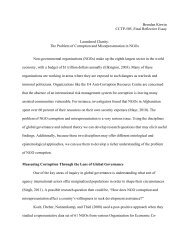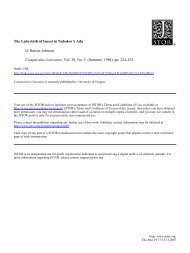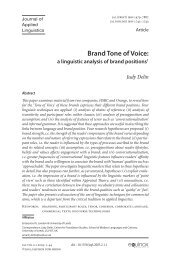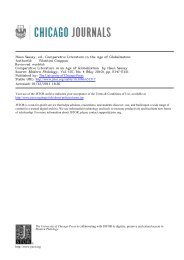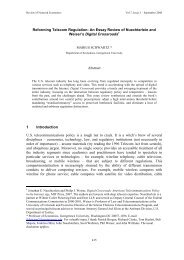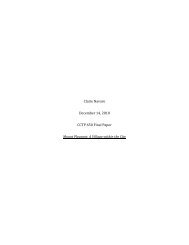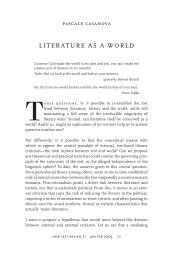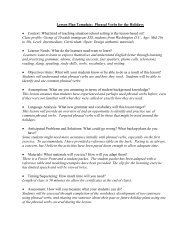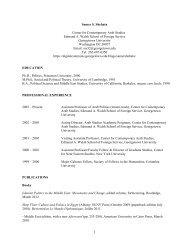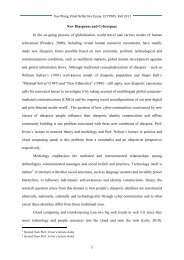roote-prokop-2013-g3-drosophila-genetics-training-all
roote-prokop-2013-g3-drosophila-genetics-training-all
roote-prokop-2013-g3-drosophila-genetics-training-all
Create successful ePaper yourself
Turn your PDF publications into a flip-book with our unique Google optimized e-Paper software.
A. Prokop - A rough guide to Drosophila mating schemes 8<br />
Figure 5. Drosophila chromosomes<br />
Cytological images of mitotic Drosophila chromosomes. Left: Female and male cells contain pairs of<br />
heterosomes (X, Y) and three autosomal chromosomes. Right: Schematic illustration of Drosophila<br />
salivary gland polytene chromosomes which display a reproducible banding pattern used for the<br />
cytogenetic mapping of gene loci (black numbers; see FlyBase / Tools / Genomic/Map Tools /<br />
Chromosome Maps for detailed microscopic images); 2 nd and 3 rd chromosomes are subdivided into a left<br />
(L) and right (R) arm, divided by the centrosome (red dot). Detailed descriptions of Drosophila<br />
chromosomes can be found elsewhere [40].<br />
4.1.2. Alleles 1<br />
Genes exist in different <strong>all</strong>eles. Most loss-of-function mutant <strong>all</strong>eles (hypo- or amorphic/null) are<br />
recessive. Their phenotypes are not expressed in heterozygous (-/+) but only in homozygous<br />
animals (-/-), i.e. the wildtype <strong>all</strong>ele mostly compensates for the functional loss of one gene copy<br />
(see w, vg or e in Fig. 6). Loss-of-function mutant <strong>all</strong>eles can also be dominant. For example,<br />
phenotypes are observed in animals heterozygous for Ultrabithorax (Ubx/+), Polycomb (Pc/+), or<br />
Notch (N/+) loss-of-function <strong>all</strong>eles, i.e. the wildtype <strong>all</strong>ele is insufficient to compensate for loss of<br />
one functional gene copy (haplo-insufficiency). Dominant <strong>all</strong>eles can also be gain-of-function,<br />
usu<strong>all</strong>y caused by over-expression of a gene product (hypermorph or "dominant negative"<br />
antimorph) or by ectopic expression or activation of a gene product, potenti<strong>all</strong>y conveying novel<br />
gene functions (neomorph). For example, BarH1 over-expression in the eye causes kidney-shaped<br />
eyes in Bar 1 /+ individuals (Fig. 6) [41], ectopic Antp expression in antennae the antenna-to-leg<br />
transformations in Antp 73b /+ (Fig. 9) [42], and Krüppel mis-expression the reduced eyes in If 1 /+<br />
animals (Fig. 9) [43]. Dominant <strong>all</strong>eles may display intermediate inheritance showing a stepwise<br />
increase in phenotype strength from heterozygous to homozygous animals. Thus, the eyes of<br />
heterozygous flies (B 1 /+) are kidney-shaped, whereas they display a stronger slit-shaped phenotype<br />
in homo- (B/B) or hemizygous (B/Y) flies (Fig. 6). Animals carrying the loss-of-function mutant <strong>all</strong>ele<br />
abd-A MX1 in heterozygosis are viable and show a weak dominant cell proliferation phenotype,<br />
whereas homozygous animals are lethal and show a strong cell proliferation phenotype [8]. Note,<br />
that the phenotype distribution in pedigrees involving dominant mutant <strong>all</strong>eles differs from those<br />
with recessive mutant <strong>all</strong>eles (Fig. 6). Also note that the existence of dominant and recessive <strong>all</strong>eles<br />
has impacted on gene names (capitalisation of the first letter), which can be confusing or even<br />
misleading (Box 4).<br />
4.1.3. Independent assortment of chromosomes<br />
Drosophila has one pair of sex chromosomes (heterosomes: X/X or X/Y) and three pairs of<br />
autosomes (Fig. 5). Usu<strong>all</strong>y, non-homologous chromosomes behave as individual entities during<br />
meiosis and are written separated by semicolon in crossing schemes (Fig. 6, Box 5). According to<br />
the second law of Mendel (law of independent assortment), they assort independently of one<br />
another during gamete formation, leading to a high number of possible genotypes (Fig. 6). A good<br />
strategy to deal with this complexity during mating scheme design is to define selection criteria for<br />
each chromosome independently (curly brackets in Fig. 6; see Box 5). The 4 th chromosome<br />
harbours very few genes and its <strong>genetics</strong> slightly differs from other chromosomes [2]. It plays a<br />
negligible role in routine fly work and will therefore not be considered here.<br />
1 see also http://en.wikipedia.org/wiki/Muller's_morphs



